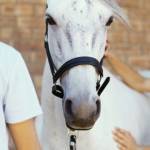Tricky Business: Assessing Body Condition from Photographs

Assessing a horse’s body condition score from a photograph can be tricky business. Sure, it’s easy to tell bag-o’-bones from pleasantly plump in photographs, but the finer points of condition evaluation might remain elusive. Only experienced handlers with access to flesh-and-bone horses will be able to determine condition scores definitively.
Yet, equine nutrition evaluations take all forms in this hustle-and-bustle world. Technology has allowed nutritionists to advise horse owners on all sorts of nutritional challenges from remote locations. Despite the most accurate physical descriptions, it is sometimes imperative for a nutritionist to actually see an image of the horse in question.
Kathleen Crandell, Ph.D., longtime nutritionist with Kentucky Equine Research (KER), values the ease with which digital photographs can be shared. Photo-sharing technology has added a much-needed dimension to her nutritional consultations. “With a photograph, even if it’s just a snapshot, it is possible for me to evaluate a horse’s general body condition. I can certainly tell if the horse is skeletal or obese.”
Familiarity with the body condition scorecard is not as widespread as many horsemen might think. Although the scorecard, which categorizes body condition on a scale of 1 (emaciated) to 9 (obese), has been in use by nutritionists and other industry professionals for many years, most horse owners do not have a working knowledge of the scores.
“The scale was created so that horsemen have a standard by which to evaluate a horse’s weight. When a colleague mentions that a horse is a 5, I know that the horse is in good weight, with a shallow layer of fat covering the ribs and other bony areas. With horse owners that are unfamiliar with the scale, one person’s idea of gaunt might be another person’s idea of fit,” said Crandell.
Crandell admits that it is unquestionably harder to come up with an exact body condition score without the advantage of seeing and touching the horse in the flesh. “The general impression of a photo can sometimes be misleading. Conformation differences will often make it hard to truly assess body fat. It is impossible to know how deep the fat cover is by merely looking at a computer monitor.”
If photographs are the only way to convey an image, it is best to offer up several shots. A full-body profile shot from either side is essential, as is a rear-view shot that allows the evaluation of width and levelness of the back. If it is possible to safely snap a shot of a horse’s withers and back from an elevated position, this might be helpful as well.
Despite the limitations of body condition assessment from photographs, Crandell agreed to evaluate the following four photos. Each pair of photos represents the same horse.
This is a Thoroughbred gelding that was seven years old in the first picture and eight years old in the second. He proved untalented on the racetrack and was purchased by a trail-riding enthusiast. As his care and nutrition improved, so did his body condition.

Crandell: In the first photo, I would give this gelding a body condition score of 3.5 or 4. The ribs and topline are prominent, and there is an absence of fat at the tailhead. In this case, the winter coat might even make the horse look like he is carrying more fat than he really is. This is a classic example of how not only time of year can make a difference in the appearance of the horse but also grooming and a little more weight. In the second picture, there has unquestionably been an increase in condition. I would score him a 5 from this photograph. He looks smoother all over. Because he is a deep-chested gelding, he may appear to be heavier than he really is, but a close look at the topline still shows little evidence of fat cover. The absence of excess body condition can also be seen with his thin neck and prominent withers. He is an attractive individual, and he is certainly benefiting from an upgrade in care.
This is a 10-year-old racing-bred Quarter Horse that is transitioning into a show horse.

Crandell: These photographs show how different poses give vastly different impressions.The first photograph is a good example of how conformation and body positioning can make a horse look skinnier than he really is. If you compare this gelding’s before picture with that of the bay gelding, the overall impression is that this gelding is skinnier, but if you really look closely this gelding actually appears to have more fat coverage. This gelding is an angular horse and not as deep-chested, which makes the differences misleading. When posed in a neck-high position such as this, it makes the gelding’s neck look very thin. Even though his croup has little fat cover, his hunter bump and protuberant hip bones make him look thinner than he is.
I do not see distinct outlines of ribs, so this already puts him up one body condition score from the bay gelding. The second photograph, taken a few months after the first, reveals little change in body condition (he might have gained a smidgen), but when compared to its companion photograph, illuminates clearly how body positioning can alter perception. It does not even appear to be the same horse. Further, in the second photo the horse is standing with his head and neck down, which lifts the back and levels the croup. Also, the background contributes to the impression of a much smoother individual because the shape of the croup is not as obvious in the second photo as in the first. This horse would rank a 4.5 in the first photo and a 5 in the second on the body condition scorecard.








